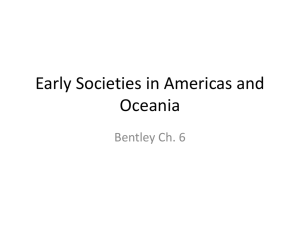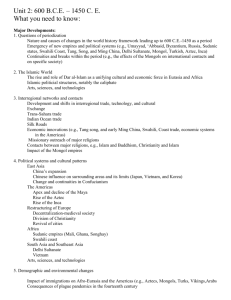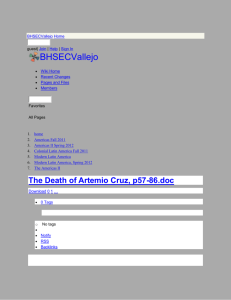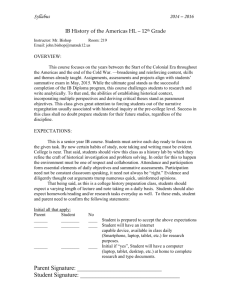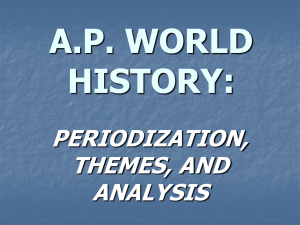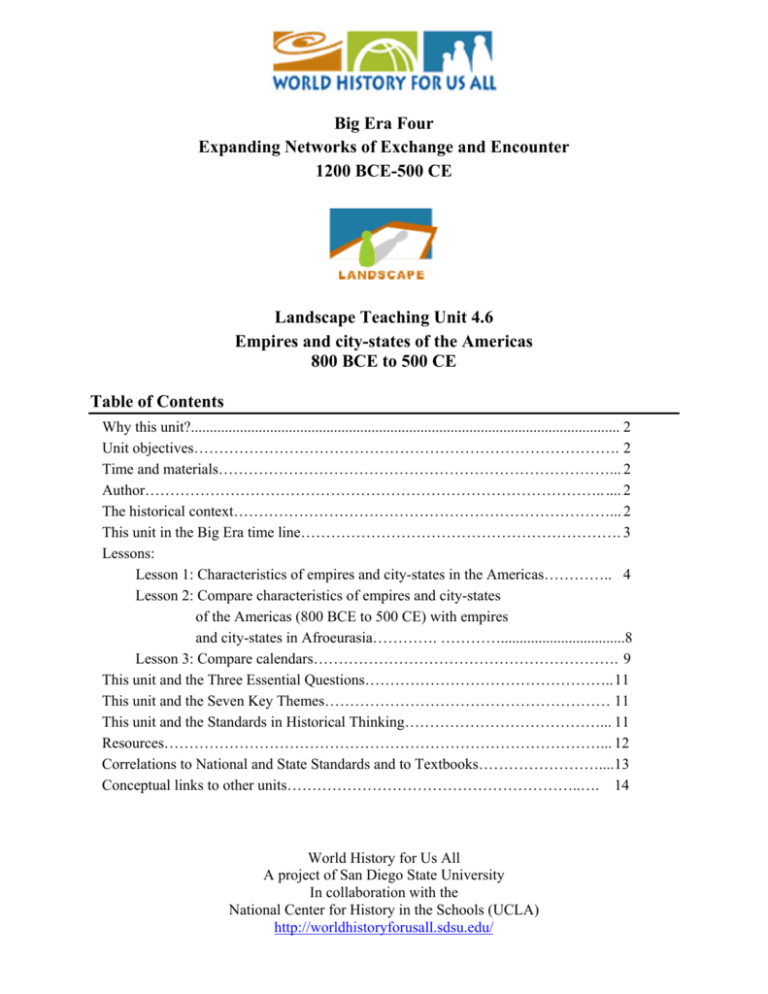
Big Era Four
Expanding Networks of Exchange and Encounter
1200 BCE-500 CE
Landscape Teaching Unit 4.6
Empires and city-states of the Americas
800 BCE to 500 CE
Table of Contents
Why this unit?.................................................................................................................. 2
Unit objectives…………………………………………………………………………. 2
Time and materials……………………………………………………………………... 2
Author……………………………………………………………………………….. .... 2
The historical context…………………………………………………………………... 2
This unit in the Big Era time line………………………………………………………. 3
Lessons:
Lesson 1: Characteristics of empires and city-states in the Americas………….. 4
Lesson 2: Compare characteristics of empires and city-states
of the Americas (800 BCE to 500 CE) with empires
and city-states in Afroeurasia…………. ………….................................8
Lesson 3: Compare calendars……………………………………………………. 9
This unit and the Three Essential Questions………………………………………….. 11
This unit and the Seven Key Themes………………………………………………… 11
This unit and the Standards in Historical Thinking…………………………………... 11
Resources……………………………………………………………………………... 12
Correlations to National and State Standards and to Textbooks……………………....13
Conceptual links to other units…………………………………………………..…. 14
World History for Us All
A project of San Diego State University
In collaboration with the
National Center for History in the Schools (UCLA)
http://worldhistoryforusall.sdsu.edu/
World History for Us All
Big Era 4 Landscape 6
Why this unit?
Although current historical evidence shows that complex societies in the Americas developed
independently of those in Afroeurasia, empires and city-states in the Western Hemisphere (800
BCE to 500 CE) shared many common elements with other complex societies of the same
period. Comparing developments in the Western and Eastern Hemispheres helps us understand
the fundamental characteristics of complex societies in both regions.
Unit objectives
Upon completing this unit, students will be able to:
1. Describe the characteristics of the empires and city-states of the Americas, 800 BCE to
500 CE.
2. Make analytical comparisons between complex societies in the Americas and
Afroeurasia.
3. Make analytical comparisons between mathematical notation and calendar systems in the
world.
Time and materials
This unit requires about a week to do all the lessons. Teachers with limited time might do the
first lesson to give students the landscape view of the empires and city-states of the Americas,
800 BCE to 500 CE.
Author
Sharon Cohen teaches world history at Springbrook High School in Silver Spring, Maryland. She
is a member of the Advanced Placement World History Test Development Committee and a
founding member of the editorial board for World History Connected: The EJournal of Learning
and Teaching. She joined the World History for Us All development team in 2002.
The historical context
This unit addresses all Three Essential Questions, because by their nature the earliest complex
societies are rooted in a specific environment that enabled the growth of settled agricultural
communities and the increasing complexity of the political, religious, and economic systems
developed in the Americas are part of what made it unique.
http://worldhistoryforusall.sdsu.edu/
Page 2
World History for Us All
Big Era 4 Landscape 6
This unit in the Big Era time line
Big Era Four 1200 BCE-500CE
800BCE-500CE
http://worldhistoryforusall.sdsu.edu/
Page 3
World History for Us All
Big Era 4 Landscape 6
Lesson One
Characteristics of Empires and City-States in the Americas,
800 BCE to 500 CE
Students will come to the study of the Americas having already looked at characteristics of
empires and city-states in Afroeurasia. They should already know that by 800 BCE human
sedentary societies developed some common social, political, and economic complexities
including social hierarchies, occupational specialization, state religions, and trading networks.
Teachers should help students to look for similar complexities in the Americas during the same
period.
Many world history textbooks explain well the characteristics of the empires and city-states of
the Americas. New research is always being made available from archaeologists that may raise
students’ interest in early American civilizations. Students should use their textbooks, other
books, and online resources listed in the resource section to complete the chart (Student Handout
1.2) cataloging the key characteristics of empires and city-states in the Americas, 800 BCE to
500 CE.
Preparation
•
Students use their textbooks or a historical atlas to identify empires and city-states of the
Americas, 800 BCE to 500 CE. Those in Mesoamerica are: Mayan, Teotihuacan, and
Zapotec. Those in the Andean highlands are Moche, Chavin, and Wari.
•
Students mark key topographical features on their maps: large bodies of water, mountains,
rainforests, and deserts.
http://worldhistoryforusall.sdsu.edu/
Page 4
World History for Us All
Big Era 4 Landscape 6
Lesson 1
Student Handout 1.1—Blank Map of the Americas
Microsoft®Encarta®Reference Library 2002. ©1991-2001 Microsoft Corporation. All rights reserved.
http://worldhistoryforusall.sdsu.edu/
Page 5
World History for Us All
Big Era 4 Landscape 6
Lesson 1
Student Handout 1.2—Chart of the characteristics of empires and city-states of
the Americas, 800 BCE to 500 CE
Maya
Teotihuacan
Zapotec
Moche
Chavin
Wari
dates when
group was
dominant
political
structure
core religious
beliefs
main
agricultural
practices
trade
networks
major
strength
major
weakness
(cause of
decline)
http://worldhistoryforusall.sdsu.edu/
Page 6
World History for Us All
Big Era 4 Landscape 6
Extension Activity
Students read archaeologists’ versions of what life might have been like in one of these complex
societies. One of the best is A Forest of Kings: The Untold Story of the Ancient Maya by Linda
Schele and David Freidel. Then, students create a story or skit that shows daily life in an empire
or city-states of the Americas, 800 BCE to 500 CE.
http://worldhistoryforusall.sdsu.edu/
Page 7
World History for Us All
Big Era 4 Landscape 6
Lesson Two
Compare characteristics of empires and city-states
of the Americas (800 BCE to 500 CE) with those
of empires and city-states in Afroeurasia
Students should compile a chart like the one below based on the information in their textbooks or
from material previously discussed in class.
Comparison of empires and city-states in the Americas with those in Afroeurasia, 800 BCE - 500 CE
Similarities
Differences
Conclusions
Agricultural practices
Domesticated plants and
animals
Domesticated animals more
commonly eaten and used
for labor in Afroeurasia
Domesticated plants in the
Americas provided all
necessary calories, vitamins,
and proteins. Farmers
planted maize, beans, and
squashes together to make a
stake for the vines and to
retain nitrogen in the soil.
Trade
Trade between regions
supplied unique items.
Trade was most common
between the urbanized
centers in Mesoamerica and
along the coast of the
Andean region making a
north-south axis. In the
eastern hemisphere, more
trade followed routes going
horizontally from east to
west, and west to east.
Trade was common in both
regions, but the scarceness
of urban areas in North
America in this period may
have limited the expansion
of trade networks in the
Americas.
Political Structures
Political structures included
a ruler, a ruling family, and
a land-controlling
aristocracy. Governments
tried to control trade routes.
In this period, states in the
Americas were relatively
smaller.
Rulers often created empires
to control extensions of
trade routes.
Religious Beliefs and
Practices
Religious beliefs and
practices linked rulers to
gods and goddesses
Although the names of some
of the deities varied, similar
beliefs and practices existed
in Mesoamerica and the
Andean highlands. In
Afroeurasia, belief systems
and practices in the various
centers of civilization
developed in different ways.
While cultural continuity
was the norm in
Mesoamerica and in the
Andean highlands, the
cultural differences in
Afroeurasia led to
syncretism and cultural
blending as empires grew
and took over peoples with
different religious beliefs
and practices.
Social and Gender
Systems
Patriarchy developed.
The key deity was the
goddess of the sun; corn
mother
Although rulers were
typically male in both
hemispheres, the role of
women as creators of life
was emphasized in both
regions.
http://worldhistoryforusall.sdsu.edu/
Page 8
World History for Us All
Big Era 4 Landscape 6
Lesson Three
Compare calendars
This lesson will take at least two days. Students will need to collect information on calendar
systems in the period 800 BCE to 500 CE for at least one class session along with time outside of
the classroom. On the second day of the lesson, students will compare calendar systems in at
least two city-state or empire. Students will then draw conclusions about the creation of
calendars.
Preparation
This lesson may take three days depending on how much research students have to do not
provided by their textbooks.
On the first day, the teacher helps students understand how the calendars they use are
constructed. For homework or on the second day, students research the characteristics of Mayan
calendars. They should discover the following basic facts:
•
•
•
•
•
solar calendar with 365 days
base 20
part of long count
used to keep track of deity days
marked days of important sacrifices
On the third day, students research characteristics of calendars for city-states and empires in
Afroeurasia, 800 BCE to 500 CE: Greek, Roman, Jewish, Chinese, Parthian, Hindu, Christian.
Students compare the purposes of calendars in the eastern and western hemispheres. What
similarities show global human concerns and what differences show unique cultural
characteristics?
Extension Activity
Use pen pals in other parts of the world to compare the answers to these questions with students
whose school systems or governments use a different calendar system.
•
•
•
•
•
•
Is it a solar or lunar calendar?
How many months in a year?
How many days in a month? How many days in a week?
Does the calendar indicate the number of hours in a day? Why or why not?
What names are given for the days of the week? Who created those names?
What kind of days are “holidays”? How many are identified in the calendar? Do you
celebrate other “holidays” that are not listed on the calendar? Why do you think they are
not listed?
http://worldhistoryforusall.sdsu.edu/
Page 9
World History for Us All
Big Era 4 Landscape 6
•
What other kinds of information are included in the calendar? Are celestial events listed
such as equinoxes, moon phases, or predicted eclipses? Why or why not?
Analyze a national holiday whose history is well known in your country. Was the date
ever changed? Why or why not? How do people in your country or region honor that
day? Do some people not care? Why or why not?
http://worldhistoryforusall.sdsu.edu/
Page 10
World History for Us All
Big Era 4 Landscape 6
This unit and the Three Essential Questions
In Egypt complex society developed in a single river valley hemmed in on both sides by
mostly flat desert. In the Andes Mountains complex society emerged on the western slopes
of the Andes Mountains, where the range of altitudes and climates was extreme. How
might these contrasting physical and natural environments have contributed to differences
in these two areas of civilization?
When large, dense populations developed in region such as central Mexico,
Andean Peru, the Tigris-Euphrates valley, Egypt, or China, was it inevitable that
society became divided between a small but rich and powerful ruling class and
the rest of the population? Can you imagine a complex society emerging in the
premodern era without most power and wealth being held by a small group?
Read excerpts the Popul Vuh, the Maya creation story. Compare this narrative of
creation with the first two chapters of Genesis in the Bible. What are differences
and similarities in the way these sacred texts account for the creation of the
world and humankind? (See Resources.)
This unit and the seven Key Themes
This unit emphasizes:
Key Theme 2: Economic Networks and Exchange
Key Theme 3. Uses and Abuses of Power
Key Theme 4: Haves and Have-Nots
Key Theme 6: Science, Technology, and the Environment
Key Theme 7: Spiritual Life and Moral Codes
This unit and the Standards in Historical Thinking
Historical Thinking Standard 1: Chronological Thinking
The student is able to (D) measure and calculate calendar time by days, weeks, months, years,
decades, centuries, and millennia, from fixed points of the calendar system.
Historical Thinking Standard 2: Historical Comprehension
The student is able to (G) draw upon data in historical maps in order to obtain or clarify
information on the geographic setting in which the historical event occurred, its relative and
absolute location, the distances and directions involved, the natural and man-made features of the
place, and critical relationships in the spatial distributions of those features and historical event
occurring there.
Historical Thinking Standard 3: Historical Analysis and Interpretation
http://worldhistoryforusall.sdsu.edu/
Page 11
World History for Us All
Big Era 4 Landscape 6
The student is able to (D) draw comparisons across eras and regions in order to define enduring
issues as well as large-scale or long-term developments that transcend regional and temporal
boundaries.
Historical Thinking Standard 4: Historical Research Capabilities
The student is able to (F) support interpretations with historical evidence in order to construct
closely reasoned arguments rather than facile opinions.
Resources
Instructional resources for teachers
Adams, Richard E. Ancient Civilizations of the New World. Boulder, CO: Westview Press, 1997.
A lively survey of Mesoamerican and South American civilizations, including
comparisons with ancient societies of Afroeurasia
Schele, Linda, and David Freidel. A Forest of Kings: The Untold Story of the Ancient Maya.
New York: William Morrow, 1990. A beautifully illustrated history of the Maya based
partly on recent interpretations of Maya hieroglyphs.
Tedlock, Dennis, trans. and ed. Popul Vuh: The Definitive Edition of the Mayan Book of the
Dawn of Life and the Glories of Gods and Kings. Rev. ed. New York: Touchstone
Books, 1996. The great Maya epic of creation and history.
Http://www.ku.edu/~mayan/resources/Syllabus.html. University of Kansas. Kaqchikel Mayan
Resource Center. A college-level course in Mayan language.
Http://www.utexas.edu/cola/llilas/centers/outreach/resources/topic/maya.html. Resource Library:
The Maya. Teresa Lozano Long Institute of Latin American Studies. University of Texas at
Austin. An annotated bibliography.
Instructional resources for students
“The Ancient Maya.” Calliope. 1999. This magazine for young people is devoted to exploring
world history. This issue focuses on Maya civilization.
http://www.usu.edu/anthro/origins_of_writing/mayan_calendar/
http://www.civilization.ca/civil/maya/mminteng.html
full descriptions with photographs of historical and contemporary Maya
http://worldhistoryforusall.sdsu.edu/
Page 12
World History for Us All
Big Era 4 Landscape 6
http://www.eecis.udel.edu/~mills/maya.html
http://jefferson.village.virginia.edu/med/ The Mayan Epigraphic Database Project
http://www.halfmoon.org/ -- Rabbit in the Moon site has activities including a talking syllabary,
and a memorial to Linda Schele
Correlations to National and State Standards and to Textbooks
National Standards for World History
Era Four: Expanding Zones of Exchange and Encounter, 6A: The student understands the
origins, expansion, and achievements of Maya civilization; 6B: The student understands the rise
of Teotihuacán, Zapotec/Mixtec, and Moche civilizations.
California: History-Social Science Content Standards
Grade Six, 7.7.5: Describe the Meso-American achievements in astronomy and mathematics,
including the development of the calendar and the Meso-American knowledge of seasonal
changes to the civilizations' agricultural systems.
New York: Social Studies Resource Guide with Core Curriculum
Unit One: Ancient World – Civilizations and Religions (4000 BC – 500 AD), C. Classical
civilizations, 5. Rise of agrarian civilizations in Mesoamerica—Mayan (200 BC-900 AD).
Virginia Standards of Learning
World History and Geography to 1500 AD. Era IV: Regional Interactions, 1000 to 1500 A.D.
WHI.11. The student will demonstrate knowledge of major civilizations in the Western
Hemisphere, including the Mayan, Aztec, and Incan.
Texas Essential Knowledge and Skills for Social Studies.
113.33 World History Studies. (c) Knowledge and Skills. 6) History. The student understands the
major developments of civilizations of sub-Saharan Africa, Mesoamerica, Andean South
America, and Asia. The student is expected to (B) Summarize the major political, economic, and
cultural developments of civilizations in Mesoamerica and Andean South America.
Textbooks
Across the Centuries (Houghton Mifflin). Chapter 15: Early American Civilizations. Lesson 3:
The Maya. Lesson 4: The Tiwanakans and the Moche.
Ancient World: Adventures in Time and Place (Macmillan/McGraw-Hill). Chapter 10: Ancient
Americas. Lesson 1: The Geography of the Americas. Lesson 3: Ancient North America.
http://worldhistoryforusall.sdsu.edu/
Page 13
World History for Us All
Big Era 4 Landscape 6
World History: The Human Experience (Glencoe McGraw-Hill). Chapter 15: The Americas.
Section 2: Early Mesoamerican Cultures.
Conceptual links to other teaching units
The empires and city-states of the Americas shared many common elements with other complex
societies of the same period. The next Landscape Teaching Unit (4.7) is titled “Long-distance
Migrations in Tropical Seas.” This final Landscape unit in Big Era Four asks students to
investigate the variety of types of societies that emerged in the vast Pacific Ocean basin. Like the
Americas before 1492, this region had little or no contact with Afroeurasia before modern times.
http://worldhistoryforusall.sdsu.edu/
Page 14

